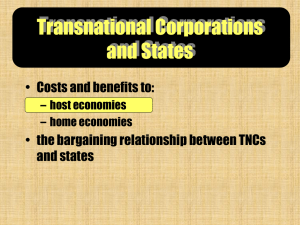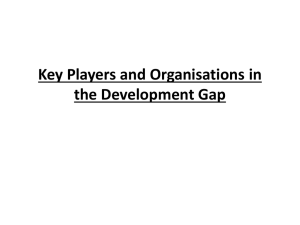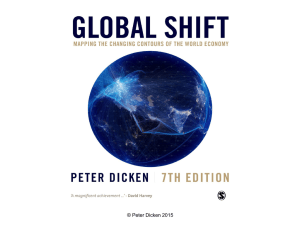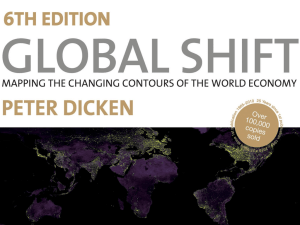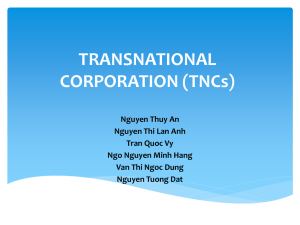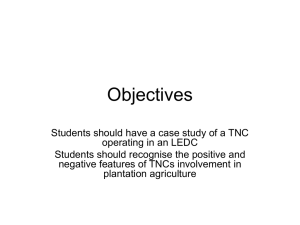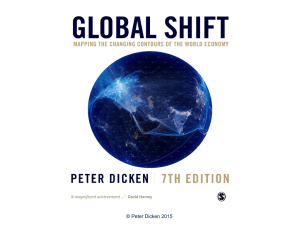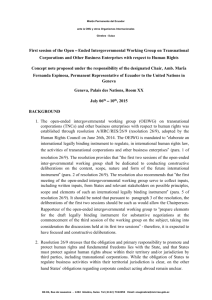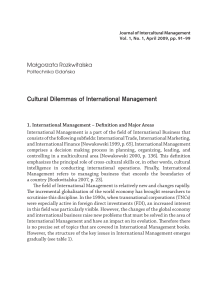Powerpoint 4 - Transnational Corporations
advertisement
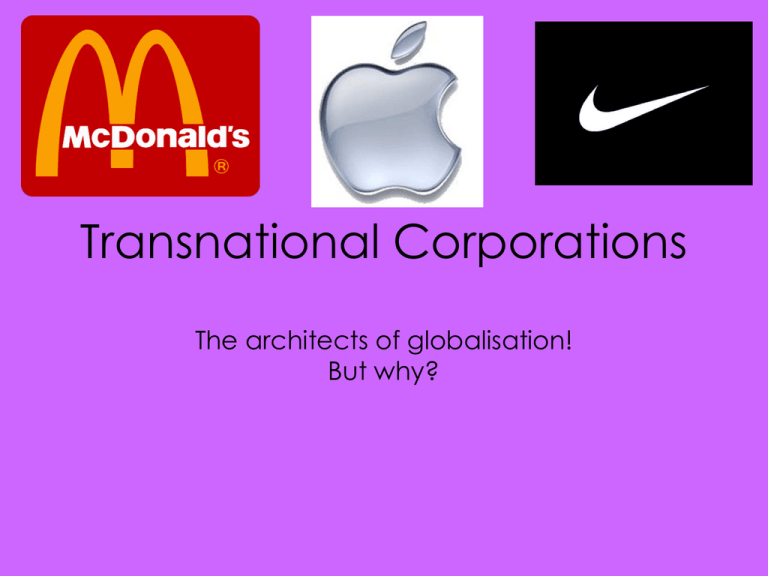
Transnational Corporations The architects of globalisation! But why? TNCs • A company that has operations in more than one country to produce or sell products and services • Help to build bridges between nations • They bolt together different economies and societies through their supply chains and marketing strategies • TNCs have their roots in the colonial businesses of the 18th and 19th century eg East India Company • TNCs build their businesses by buying foreign firms in mergers or acquisitions • Much of the manufacturing is subcontracted to third parties. This can make it difficult to enforce good factory working conditions • Most TNCs are assembly industries – manufacturing operations that take the products of many different industries and fit them together to make finished goods. They rely on a chain of suppliers. Some many be made by independent subcontractors and others are owned by the parent company The car industry is a perfect example of how a production line relies on thousands of different parts that are then assembled in one location. The car industry was also the first real TNC when Henry Ford started mass producing cars on an assembly line over a 100 years ago – called FORDISM • Eg the Mini factory in Oxford is owned by BMW and 2500 suppliers provide parts to assemble the mini. Some are from inside the EU to avoid tariffs and others like the engine are brought all the way from the factory in Brazil that is part owned by BMW. • Some of the parts may be sourced locally and then assembled close to the market. This is called glocalisation. Name some TNCS!! Can we map TNCs? • It is incredibly difficult to map the geography of a TNC • This is because the largest TNCs often have offices, factories (called branch plants)or shops in every country of the world • Because of these complex networks, it is important to remember that TNCs still have to belong to somewhere i.e. The parent company is registered to a particular place. • Often this is the place where the bulk of their assets are, the nationality of the board of directors, the country they would turn to for diplomatic support and hwere they pay taxes. • Although TNCs may operate all over the world, most TNCs promote common patterns of consumption i.e. they sell the same, or similar product everywhere. Though they may tweek the products slightly, another part of glocalisation! Eg Cadbury make their chocolate sweeter in China Russia French Canada China Argentina The HQ of TNCS • See p 104 Philip Allan How do TNC’s grow? Motive – Profit. They control costs of raw materials and production costs, and do this by merges and take over's in 3 ways. 1) Horizontal integration – Buying up competition. 2) Vertical integration – controlling and owning every stage of production. 3) Economies of sale – expand production to increase efficiency and reduce unit production costs. Means – The banks. Companies invest overseas too, to boost their market or take advantage of labour or environmental laws. Flows of money around the world connect businesses and countries. Mobility – Transport and communications. Accelerated and cheaper transport (containerisation and cheap flights) and communication systems (fibre optics) along with production systems such as ‘just in time’ (companies demand goods on short time scale rather than holding stock) which provides cheap fast turn around, enabling companies to be faster than their competitors. How do TNCs affect global wealth? TNCs bring Foreign Direct Investment to nations – even if wages are low workers will still spend money after they have been paid = stimulates growth of other local services When TNCs locate in a trade bloc they bring wealth to poorer regions as they often source parts locally One of the most effective mechanisms for wealth redistribution The wealth of TNCs compared to the wealth of countries • See pg 107 Philip Allan Are TNCs a problem or a solution? • Read the Geofile sheet For • Raising living standards – TNCs invest in the economies of the developing nations • Transfer of technology – south Korean firms e.g. Samsung have learned to design products for foreign markets • Political stability – investment by TNCs has contributed to economic growth and political stability e.g. China • Raising environmental awareness – due to large corporate image TNCs do respond to criticism e.g. Co-op has ‘green credentials’ Against • Tax avoidance – many avoid paying full taxed in countries they operate in through concessions • Limited linkages – FDI does not always help developing nations economies • Sweatshops – workers are employed for long hours, low pay in poor conditions • Growing global wealth divide – selective investment in certain global areas is creating a widening divide e.g. Southeast Asia vs. sub-Saharan Africa • Environmental degradation – example of Bhopal, India disaster in 1984 So lets look at an example of a TNC p 105-106 Philip Allan • Tesco is not just located in the UK (as I’m guessing many of you had thought!) • It is now a global empire worth around £67 billion a year Tesco Troubles • This is Tesco’s latest venture – a health food chain in the USA • So far invested $700 million • Initial sales were down by a reported 70% • It is also believed that due to this investment Tesco is now struggling to compete with the growth Asda has seen in the UK Research Nike • Produce a detailed fact file about Nike: • • • http://www.nikeresponsibility.com/report/content/chapter/businessoverview#infographic200 http://en.wikipedia.org/wiki/Nike,_Inc. http://www.iol.co.za/business/business-news/adidas-nike-puma-workersabused-report-1.1248044 Google and China • Read the article about Google and China How do you interprete this cartoon? Tasks Pearson p 87 • Exam practice questions 1 and 2 • Philip Allan p 108 • Skills focus Qs

